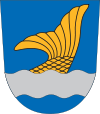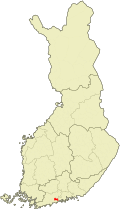Vantaa
| Vantaan kaupunki - Vanda stad | |||||
|---|---|---|---|---|---|
|
|||||
| Founded | 1974 | ||||
| Province | Southern Finland | ||||
| Region | Uusimaa | ||||
| Sub-region | Greater Helsinki | ||||
| Area - Of which land - Rank |
243 km² 240,84 km² ranked 316th |
||||
| Population - Density - Rank |
190 058 (2007) 790.1 inh./km² ranked 4th |
||||
| Unemployment | 7.7% | ||||
| Official languages | Finnish, Swedish | ||||
| City Manager | Juhani Paajanen | ||||
| Home page | http://www.vantaa.fi/ | ||||
Vantaa (IPA: [ˈʋɑntɑː]; Vanda in Swedish) is a city and municipality in Finland. Helsinki, Vantaa, Espoo, and Kauniainen make up the Helsinki Metropolitan Area.
Vantaa, with its population of 190,058, (as of 31 January 2007) is the fourth most populated city of Finland. The biggest airport in Finland, the Helsinki-Vantaa Airport, is located there. It also hosts a science centre, Heureka.
Vantaa is known for being the birthplace of the famous Finnish race driver Mika Häkkinen. Mika Salo, another car racer, has also lived there in the district of Martinlaakso.
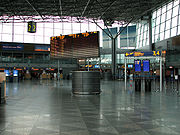
In addition there is the city museum next to the railway station in Tikkurila. The museum is housed in the oldest station building in Finland, designed by Carl Albert Edelfelt and completed in 1861. There are exhibitions with various themes on local history.
Contents |
Geography
Location
Vantaa encompasses 243 km², of which 1.90 km² is water. Population density is 790.1/km². It borders Helsinki, the Finnish capital, which is to the south and southwest. Other neighbouring municipalities are Espoo to the west, Nurmijärvi, Kerava and Tuusula to the north and Sipoo to the east.
Subdivision
Vantaa is divided into 5 districts (finn. palvelualue): Tikkurila, Korso-Koivukylä, Hakunila, Myyrmäki and Martinlaakso.
History
The name Vantaa was taken into use in 1972 when the municipality gained market town rights. The first record of the area is as Helsinge in 1351 when king Magnus II of Sweden granted salmon fishing rights on the river Vantaa to the Estonian Padise monastery. The municipality was formerly known as Helsingin maalaiskunta "Rural municipality of Helsinki". The rapids of river Vantaa were known as Helsingfors, from which the current Swedish name of Helsinki derives. In 1972, the municipality was renamed Vantaa and promoted to a market town (i.e. Vantaan kauppala), and in 1974, finally renamed Vantaan kaupunki "City of Vantaa".
On October 11, 2002, the city was shocked by the explosion of a bomb in the local Myyrmanni shopping centre, killing 7, including the bomber, a 19-year-old chemistry student from the Espoo-Vantaa Institute of Technology (see Myyrmanni bombing).
Climate
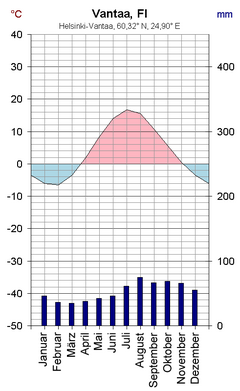
Demographics
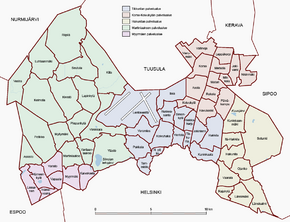
| Year | Population |
|---|---|
| 1805 | 4 840 |
| 1865 | 6 974 |
| 1880 | 7 819 |
| 1890 | 8 865 |
| 1900 | 11 110 |
| 1910 | 18 321 |
| 1920 | 22 368 |
| 1930 | 23 558 |
| 1940 | 31 511 |
| 1950 | 14 976 |
| 1960 | 41 906 |
| 1970 | 72 215 |
| 1980 | 129 918 |
| 1990 | 152 263 |
| 2000 | 176 386 |
| 2007 | 190 058 |
Politics
Municipal council
| Party | Election results[1] | Seats | Votes |
|---|---|---|---|
| National Coalition Party | 28.1 % | 20 | 22 566 |
| Social Democratic Party of Finland | 25.6 % | 18 | 20 498 |
| Green League | 13.8 % | 9 | 11 105 |
| True Finns | 9.8 % | 6 | 7 837 |
| Left Alliance | 7.7 % | 5 | 6 209 |
| Center Party | 5.6 % | 4 | 4 497 |
| Christian Democrats | 3.7 % | 2 | 2 946 |
| Swedish People's Party | 3,5 % | 2 | 2 825 |
| Pro Vantaa | 1,4 % | 1 | 1 132 |
Sister cities
 Askim, Norway (1951)
Askim, Norway (1951) Frankfurt an der Oder, Germany (1987)
Frankfurt an der Oder, Germany (1987) Huddinge, Sweden (1951)
Huddinge, Sweden (1951) Jinan, China (2001)
Jinan, China (2001)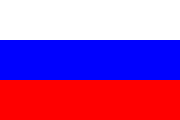 Kineshma, Russia (1969)
Kineshma, Russia (1969)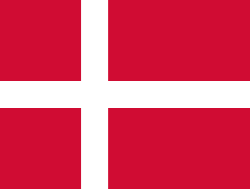 Lyngby-Taarbæk, Denmark (1951)
Lyngby-Taarbæk, Denmark (1951) Matte Yehuda Regional Council, Israel (1967)
Matte Yehuda Regional Council, Israel (1967)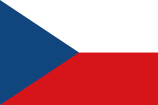 Mladá Boleslav, Czech Republic (1978)
Mladá Boleslav, Czech Republic (1978) Nuuk, Greenland (1965)
Nuuk, Greenland (1965) District of Rastatt, Germany (1968)
District of Rastatt, Germany (1968) Salgótarján, Hungary (1976)
Salgótarján, Hungary (1976) Seyðisfjörður, Iceland (1980)
Seyðisfjörður, Iceland (1980) Słupsk, Poland (1987)
Słupsk, Poland (1987)
Mayors
- Lauri Lairala 1974-1989
- Pirjo Ala-Kapee 1989-1997
- Erkki Rantala 1997-2003
- Juhani Paajanen 2003
See also
- Districts of Vantaa
- People from Vantaa
References
External links
- Municipality Official site
- Map of Vantaa
- The Finnish Science Center
- Helsinki-Vantaa International Airport
- Vantaa City Museum
- Helsinki.fi - Helsinki region in a nutshell
| Municipalities of Uusimaa |  |
|
| Ekenäs | Espoo | Hanko | Helsinki | Hyvinkää | Ingå | Järvenpää | Karis | Karjalohja | Karkkila | Kauniainen | Kerava | Kirkkonummi | Lohja | Mäntsälä | Nummi-Pusula | Nurmijärvi | Pohja | Pornainen | Sammatti | Siuntio | Tuusula | Vantaa | Vihti | ||
| Uusimaa Region | Southern Finland | Finland |
